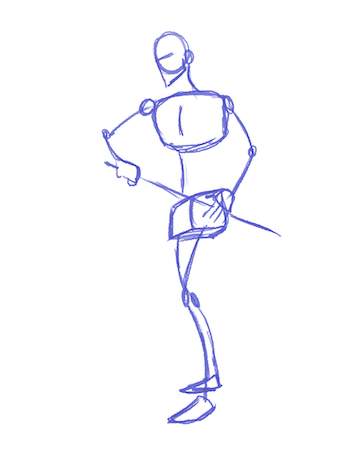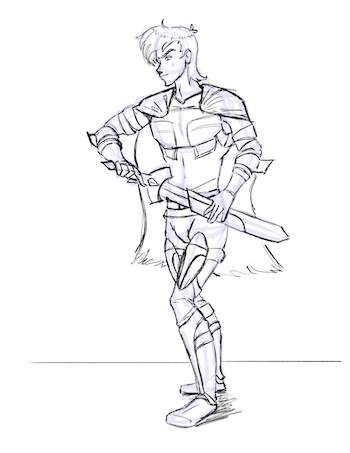Imagine your favorite video game without the main character. No Mario, no Link. Sonic is actually a rabbit and not a hedgehog.
Weird stuff, right?
(And yes, Sonic was actually first thought up to be a rabbit, then under consideration to be an armadillo before eventually becoming the classic hedgehog—check out these other video game facts.)
I mean, we might have held these different character concoctions in the same glowing regard—or maybe not? Perhaps Mario is Mario because his name is Mario and he is an Italian plumber, and anything else would have fallen flat.
Thankfully, we will never know.
Point is, character matters, and choosing the right (or wrong one) can significantly alter a game’s chance at success.
Why character design matters
Character's are more than just simply a person or visual representation. They are the driving force behind connecting gaming audiences to game stories. A good character can help a player enjoy the game they’re playing, but a great character can make a player fall in love with that game.

Character design process
So, it’s crucial for game designers to put resources into first learning the basics of character design and the thought process behind creating a classic, lovable character before moving on to creating concept art, and then finalizing character art for 3D creation.
1. Define the character
When it comes to designing a character, these questions help creators think about who their character is, and what personality their character will take on prior to drawing out a design.
Where is the character from?
A great place to start when designing a character is to think about what era or location the character is from. This is an important step because it sets the stage for the eventual environment and backdrop the character will traverse.
For example, a full armored knight would fit a renaissance castle. And a suited-up space marine would fit a futuristic space war. Think about the time period too—the 1980's style of clothing and personality is vastly different than what took place in the 1920's.
What’s the character’s name and what do they look like?
Once a time period and location have been chosen, it's time to create some baseline stats! The list below provides a starting point, but designers shouldn’t feel limited to just these differentiators. For instance, anyone who has ever played a role-playing tabletop game can think of the different stats they might need to define.
- Name
- Age
- Height
- Eye color
- Hair color
- Defining physical characteristics (scars, blemishes, moles, etc.)
- Birth home/current residence
What’s the character’s redeeming characteristic?
Every character has a redeeming characteristic about them; a trait that is good and positive. It could be that the character is kind, passionate, charming, loyal, patient, or anything else that could be thought of as a “plus!”
What’s the character’s fundamental flaw?
All that said, every well-written character also has a fundamental flaw—something about them that is not so good, or even detrimental; something that they will struggle with throughout their story.
This is sometimes the main struggle that the character is trying to learn from or overcome on their quest, and can be anything from a personality that is rude or mean-spirited, to developed insecurities, impulsive stealing, etc.
What’s the character’s motivation?
The last thing to think about is the character's motivation. Why are they here? What journey are they wanting to go on, and why?
Maybe it’s a star-crossed lover who is traveling the world to save their partner. Or a knight who must slay the demon dragon to save their hometown. Perhaps it’s a space explorer who is trying to discover the next planet suitable for human life.
Basically, why is your character in this game?
2. Bring the character to life
After forming the character backstory, it’s time to move on to forming the actual character!
From anatomy to common physical poses, there are a few different considerations at this point in the character design process.
Anatomy
It may sound like a given, but fully understanding human anatomy is a must for anyone wanting to create an accurate 3D model. (This is, of course, assuming the main character is human! For those using animals or other objects as characters, the same care should be exercised.)
Basic anatomy points to become familiar with include basic bone structure, as there are over 200 bones in the human body!

Character designers should be familiar with the main pieces, including:
- Head: Forehead, eyes, nose, ears, lips, mouth, and jaw.
- Torso: Ribcage, hips, and soft “twistable” area of stomach, etc.
- Arms: Shoulders, upper arm, elbow, and lower arm
- Hands: Wrist bone, palm, fingers, and thumb
- Legs: Upper leg, knee, and lower leg
- Feet: Heel, midfoot, and toes.
Poses
When practicing drawing a character, designers may want to explore different physical poses their character might find themselves in. Trying out different facial expressions, action shots, fighting stances, etc. is a great way to explore and define who the character is and how they carry themselves.
(Check out Draw with Jazza: Creating Characters, a book for awesome reference poses for characters.)
Read More: How to Draw From Reference
Drawing poses is all about breaking the drawing down into basic shapes. Think of it as deconstructing those anatomical landmarks that were covered earlier.
3. Draw the character
As with anything, there is more than one way to succeed, but here are a few steps a designer can follow when beginning to draw their character.
Step 1: Break down the drawing into simple shapes and lines.
For example, using a sphere for the chest, cube for the hips, sphere for the head and a triangle for the chin, lines for each limb, triangles for feet and lines for each finger.

Step 2: Add in the anatomy.
Next, it's time to create body landmarks into your sketch. This step builds on the previous sketch layer, but still stays rough and explorative.
Step 3: Fill in the details of your character.
Now is the time to add in the details of who the character is and explore the features within creative design.

4. Design the character
When it comes to designing a character's look, it's important to know who they are and how the audience should feel about them.
Traits
With traits, it’s useful for designers to write out 3 to 5 words that summarize up what attributes they want the audience to feel when they look at the character.
Showcasing Traits
Now, it's time to think about and find ways of expressing who the character is through their visuals.
Eyes: The saying goes that "eyes are the gateway to the soul," and even how a person's eyes are shaped can say a lot about them. A furrowed brow alludes to an angry soul, while strong laugh lines mirror a happy spirit. Eyebrow shapes can easily tell something special about the character.
Jawline: Strong jawlines could tell the audience that a character is bold, tough, and confident. Meanwhile softer jawlines emote feelings of youth and kindness.

Nose shape: There are many different styles of noses for characters. A hooked or crooked nose showcases mysterious past or perhaps a nefarious schemer. Small button noses are good for cute, young, and innocent characters. Strong angular noses are great for confident or tough characters.
Read More: Graphic Design Projects for Beginners
Get Started: Graphic Design Courses for Kids & Teens
Ears: Ears can describe certain mystical characters like elves or orcs, but they can also be adorned with jewelry that will speak about the person. Someone with elegant traditional earrings may come from royalty. Stark metalwork earrings on the other hand could be used for harsher, more misunderstood characters.

Shape Theory
There are three basic shapes that can be used to draw characters: circles, squares and triangles.
Each shape means something to the subconscious mind. This shape language ties through the entire character, from the basic body shapes, to details like the shapes of their eyes or ears.
Circles: Circles can be used for characters that have any of these words: soft, sweet, kind, gentle, open, approachable, honest, caring, young, naive, gullible, unsure, worldly, nature-driven, etc.
Squares: Squares can be used for characters that have any of these words: strong, confident, trustworthy, cocky, brash, action-oriented, driven, pushy, committed, arrogant, dependable, even-tempered, etc.
Triangles: Triangle shapes can be used for evil characters, but also used for: speedy, calculating, cunning, hot-headed, rougue-like, stealthy, emotional, loving, quick-thinker, slick, elegant, etc.
5. Begin the 3D design
At this point, character designers have a reference library, have learned the basics of design theory, and studied the basics of sculpting, which means it’s time to think about creating the character's concept art.
That also means design isn’t far from finalization and making its way to Autodesk Maya, the industry standard for creating TV shows, games, movies, and more!
Not only can Maya create cute and stylized characters, but it's been used for more photo-realistic character types as well. Maya's unique modeling pipeline allows artists to create whatever visuals they can think of!
So, have a kid or teen who has a video game or drawing interest? Check out our drawing fundamentals course, online learning classes and game design summer camps for a number of cutting-edge learning opportunities.
